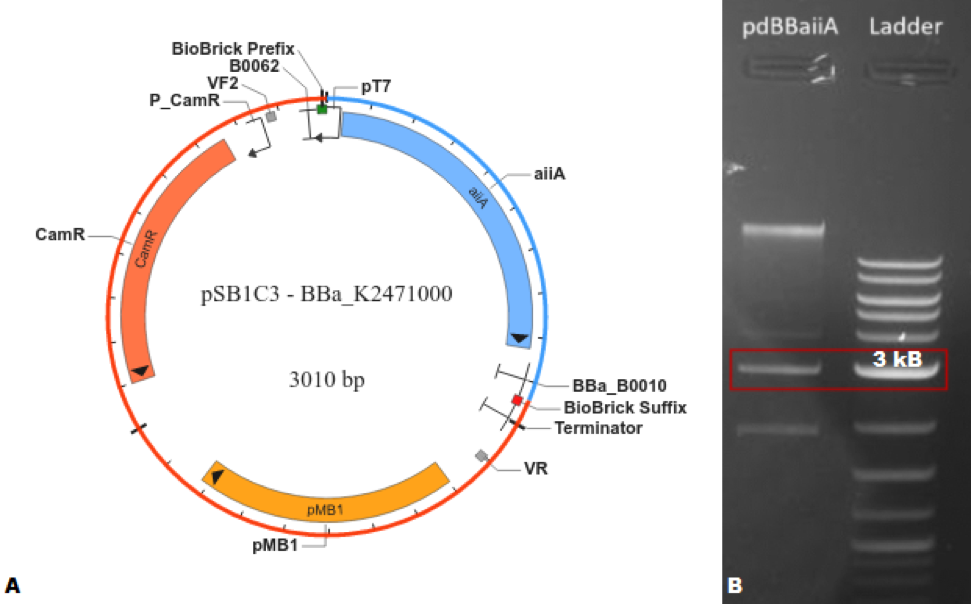Part:BBa_K2471004
Expressible N-acyl homoserine lactonase from Bacillus sp. A24
This BioBrick™ is a brand new addition to the Parts Registry, it contains the necessary genetic circuitry to constitutively express the team's new aiiA gene (BBa_K2471013), that when expressed, results in the production of the aiiA enzyme, and thus, the quenching of quorum sensing thanks to the decrease in AHLs.
A chassis with the T7 polymerase gene is needed for the successful expression of this BioBrick™.
Usage and Biology
The aiiA gene was of such relevance to the project's development because of its function since it's responsible for the inhibition of two of Erwinia amylovora's main virulence factors: the type III secretion system and the production of exopolysaccharides. Quorum sensing regulates, among many other cell functions, both of these; therefore, by disrupting the quorum sensing, the bacteria will lose these virulence factors. The epsE gene, in the same way, constitutes a fundamental part of the project, since it eliminates cell motility by promoting the separation of the flagellum from the motor proteins located in the cell membrane. Each BioBrick® presented in this section is a new and functional addition to iGEM's Parts Registry, since both's codifying genes' sequences are different from the ones in the catalog (and are confirmed to codify for their respective proteins, unlike the parts that are already in the Parts Registry, which is reported as being putative) and were synthesized thanks to the sponsorship granted by IDT®. These two new BioBricks® (aiiA: BBa_K2471004 and epsE: BBa_K2471005) were transformed into Escherichia coli BL21(DE3) (both) and Erwinia amylovora (just aiiA). After performing polyacrylamide gel electrophoresis, it was concluded that our new aiiA BioBrick is functional because the protein was expressed in both bacterial types that it was transformed into; on the other hand, the epsE BioBrick didn't work, since no protein expression was found in Escherichia coli BL21(DE3).
Characterization of the aiiA gene by Tec-Chihuahua
Two of the three bioparts critical to our project, aiiA (BBa_C0060) and epsE (BBa_K143032), are reported as being putative; this means that these sequences are classified as those genes based on empirical evidence, it hasn't been completely proven that they codify for their supposed proteins, it’s purely hypothetical. Because of this, we synthesized two new BioBricks with sequences that are reported to code for our proteins of interest; both have the genetic circuitry necessary to correctly express their confirmed genes. The first one, BBa_K2471004, codifies for aiiA, an N-acyl homoserine lactonase from Bacillus sp. A24 (NCBI GenBank: AF397400.1) and has a molecular weight of 29.45340 kDa; the other one, BBa_K2471005, codes for a glycosyltransferase family 2 protein from Bacillus subtilis (NCBI Reference Sequence: WP_032722561.1) with a molecular weight of 32.17317 kDa. This decision was taken to reduce the chances of problems during the expression of said enzymes.

Figure 1. (A) SnapGene® map of BBa_K2471000. (B) Agarose gel (1%) electrophoresis of BBa_K2471000 compared with NEB Quick-Load® Purple 2-Log DNA Ladder (0.1 - 10.0 kb), where the highlighted bands correspond to approximately 3,000 base pairs.
Sequence and Features
- 10INCOMPATIBLE WITH RFC[10]Unknown
- 12INCOMPATIBLE WITH RFC[12]Unknown
- 21COMPATIBLE WITH RFC[21]
- 23COMPATIBLE WITH RFC[23]
- 25COMPATIBLE WITH RFC[25]
- 1000COMPATIBLE WITH RFC[1000]
| None |
